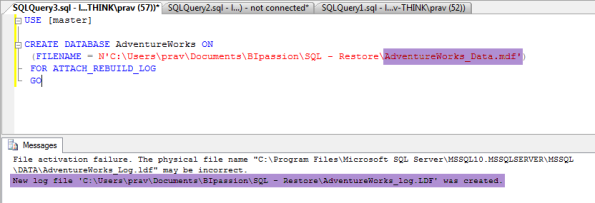Archive
Posts Tagged ‘SQL – Restore’
SQL – Database restore using mdf file
August 12, 2011
Leave a comment
Recently, one of my team member asked me to restore a database by providing only mdf file. This restoring process is really interesting and simple process as it is not using .bak file.
I am simulating this process using AdventureWorks Database.
Step 1: Database backup – In case of any disaster process as I wouldn’t take any chance of loss of data.
USE AdventureWorks BACKUP DATABASE AdventureWorks TO DISK = 'C:\AdventureWorks.bak' GO
Step 2: Analysis of file filegroup using sp_helpfile
USE AdventureWorks EXEC sp_helpfile
As we could see, primary and log files and its size (size of log file need to consider)
Step 3: Stop SQL Server services to copy the mdf file of database as we couldn’t take a copy of mdf file while services are running.
Step 4: I have just copy the mdf file to local system folder.
Step 5: Start SQL Server services and delete the existing AdventureWorks Database
Step 6: Restoring Database using mdf file as
USE [master] CREATE DATABASE AdventureWorks ON (FILENAME = N'C:\Users\prav\Documents\BIpassion\SQL - Restore\AdventureWorks_Data.mdf') FOR ATTACH_REBUILD_LOG GO
Step 7: Verify the Database and file group
Step 8: Verifying the filegroup of restored database (ldf file created)
USE AdventureWorks EXEC sp_helpfile
Points to consider:
1. Don’t recommend to do this approach on production without having disaster recovery plan.
2. Need to consider the filegroup files, if we have mdf and many ndf files the system may not restored so we may need to move data from ndf file to mdf file.
3. There are many other approaches to solve this issue as it is my personal approach to implement this process.
Categories: SQL Server
SQL - Restore









